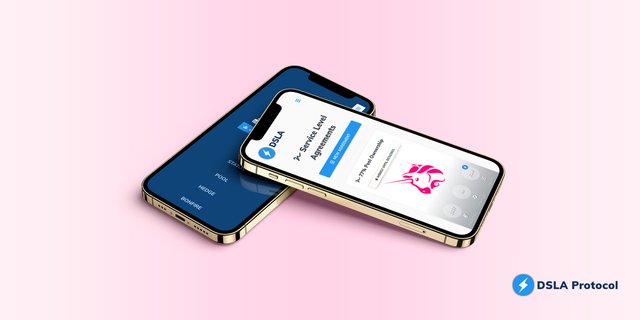Up 100x Risk Reduction
Dear community, the core development team of DSLA Protocol is pleased to announce that we have successfully deployed DSLA Protocol v1.1 earlier today, to the Ethereum mainnet. 🎉
Protocol Creation
0x2b3a823843669d6381e6e68038805839f179dccf21c261365515944420c929aa
Protocol Initialization
0xb137b0c64cf1830681da22813aa29e180b45680838bacdad83b996ed436f287b
Our Github repository will be public very soon, and the DSLA Protocol smart contracts will be verified on Etherscan shortly.
Along with security updates and gas optimizations, DSLA Protocol v1.1 is pioneering a new 100x Leverage Risk Trading capability, that enables developers, liquidity providers and users to supercharge their SLA Futures positions with a reduction and exposure multiplier.
Why it’s a big dealWhy it’s a big deal
In insurance products, funds are typically pooled together, to lower the cost of insurance premiums for policyholders. A common design assumption is that there will always be enough available capital in the pool to settle claims. While it is often the case, this also means that potentially large sums are sitting in the liquidity pool, with little utility or yield.
On DSLA Protocol, each Decentralized SLA has its own, independent liquidity pool. With this ceiling in place, agreements can both offset failures and reward successes with great accuracy and capital efficiency.
Leverage Risk Trading further enables developers and liquidity providers to increase the attractiveness of their SLA contracts on the DSLA marketplace, and modulate the cost of SLA premiums for participants.
e.g. As a Harmony ONE delegator, a 10x DSLA contract would entitle you to a 10 times bigger compensation, if the contract is breached.
This also means that you only need to stake 10 1ONE tokens to a DSLA contract, to protect 100 ONE at risk elsewhere.
Of course, we are just using 1ONE tokens as an example here, as DSLA Protocol only officially supports DSLA, DAI and USDC staking (for now).
DSLA Protocol v1.1
Here is a summary of the in-house innovations included in DSLA Protocol v1.1:
- Risk Prediction Markets, enabling developers, users, and liquidity providers to trade risk with each other using Decentralized Service Level Agreements (SLA);
- Leveraged Risk Trading, enabling developers, users, and liquidity providers to better market their SLA contracts and modulate the cost of SLA premiums;
- Reliability Forecasts, enabling third-party risk assessment at a glance, through the wisdom of the SLA marketplace and its participants;
- SLA Futures Positions, tokenised LONG/SHORT positions issued to the SLA creator taking on risk (LONG), or to SLA users offsetting risk (SHORT);
- A Triple Token Design, to separate the functions of SLA enforcement, and tokenisation of LONG/SHORT SLA positions;
- SLA Staking Rewards, to incentivise the creation of decentralized service level agreements, and the availability of subsequent reliability forecasts;
- Native Token Burns, everytime a SLA is verified, to ensure the long-term sustainability of DSLA Protocol and utility of DSLA Token;
Programmable SLAs, enabling the addition of new types of SLAs and use cases over time, developed by the community; - Developer Tools, enabling developers to add risk management capabilities to their service, or design risk-aware customer experiences from scratch;
- No Code Tools, enabling third-party service providers to add risk management widgets to their service, without technical knowledge.
Audit Status
3 Successful Audits
At this stage, along with our comprehensive internal testing, we have received three security audits of the DSLA Protocol:
- An audit from leading german security firm Chainsulting
- An audit from an independant white hat security expert and member of the Hackerone community
- An audit from leading smart contract auditor CertiK
All high and critical issues raised during this triple audit have been addressed.
The aforementioned security auditors are in the process of wrapping up their respective reports for DSLA Protocol v1.1. We will share them with the community, and attach them to official DSLA Protocol smart contract on Etherscan, as soon as they are available.
Security Bounty
We encourage white hats to keep submitting their findings using the security bounty campaign we put in place with our friends at Immunefi.
Don’t miss our flagship Ðapp launch
Following this successful release of DSLA Protocol v1.1, our flagship Ðapp will launch on April 14, 2021 at DSLA.network.
Ready to turn DeFi risk into an asset with DSLA Protocol?
About DSLA Protocol
DSLA Protocol is a risk management framework that enables developers and infrastructure operators to reduce their users exposure to service delays, interruptions and financial losses, using self-executing service level agreements, bonus-malus insurance policies, and crowdfunded liquidity pools.
Its flagship use case is to offset the financial losses of proof-of-stake delegators and DeFi users, while incentivizing the good performance and reliability of staking pool operators and DeFi service providers such as Uniswap (AMM) and OpenSea (NFT).
To learn more about DSLA Protocol, please visit stacktical.com, browse our official blog, and follow @stacktical on Twitter.


You've got a free upvote from witness fuli.
Peace & Love!
Downvoting a post can decrease pending rewards and make it less visible. Common reasons:
Submit